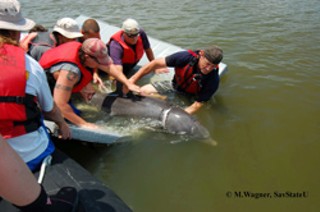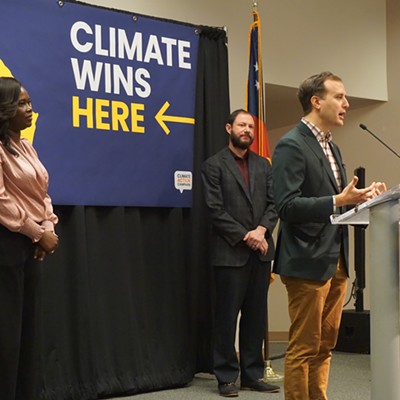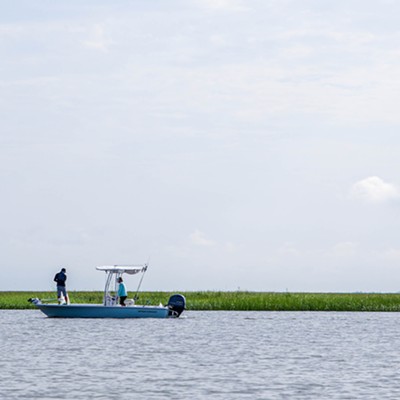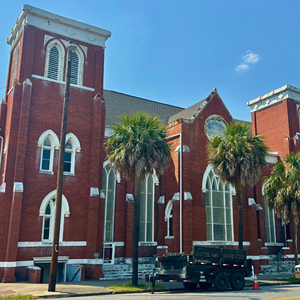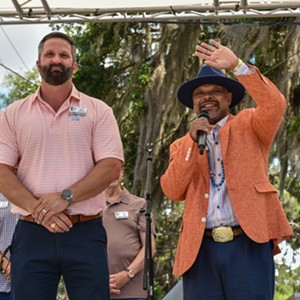IT WAS April 2007 that the dolphin was first spotted.
It was immediately obvious that something was wrong. The dolphin appeared to have a black rubber cord around its neck.
A year later, the dolphin was seen again and it was obviously in serious trouble. It had grown, and the object around its neck had tightened into a noose that ate into the dolphin’s skin, leaving a wound 2 inches deep.
On July 1, about 30 dolphin experts and volunteers from the Georgia Department of Natural Resources, the National Oceanic and Atmospheric Administration, Savannah State University, the Dolphin Project of Coastal Georgia, the University of North Carolina-Wilmington, the University of Georgia Marine Extension, the Georgia Sea Turtle Center and the Harbor Branch Oceanographic Institute -- all members of the Southeast Regional Marine Mammal Stranding Network -- gathered on the Wilmington River to attempt a rescue.
“We launched a rescue effort for this dolphin because the animal was entangled in marine debris and the entanglement was life-threatening,” says Jenny Litz, a fisheries biologist with NOAA. “As the dolphin was growing, the piece of rubber was tightening around its body and could have led to infection.”
“They used an enormous net to encircle the dolphin and pulled the net in and got her out of the water,” says Peach Hubbard, president of The Dolphin Project. “Usually, a dolphin will be thrashing and trying to get away. She was calm the whole time. She knew we were there to help her.’
When the dolphin was captured, the object turned out to be a rubber loop. “I called it a gasket because of the way it was made.” Hubbard says. “It would have gotten caught around the dolphin’s neck when she was barely a year old and as she grew, it dug in.”
Dr. Terry Norton of the Georgia Sea Turtle Center cut the loop off, then took the dolphin’s vitals, inoculated her and removed polyps. Statistics were taken, the dolphin’s fin was tagged and, because the rubber loop hadn’t reached any vital organs, she was released.
“We were thrilled to be able to do that,” Hubbard says. “She was seen a week later, leaping out of the water.”
Hubbard and her husband, Roy, have been a part of The Dolphin Project for five years. “I’ve never had an experience like this in my life,” she says.
Dr. Tara Cox of Savannah State University was at the scene of the rescue, and is hoping to follow the dolphin’s progress. If anyone sees the dolphin, which will be recognizable because of a pink dorsal tag, they should call Cox at 356-2310 or e-mail [email protected].
“The dolphin was apparently only about two or three years old,” Cox says. “It’s lucky the rubber did expand, and the injuries weren’t nearly as bad as we feared they would be.
“The rubber gasket had cut through the skin and some of the blubber,” she says. “It hadn’t gotten all the way to muscle. Dolphins have internal organs, then a layer of muscle, then a layer of blubber, and it essentially protected it from injury. There’s not much blood flow going through that.”
But because the outcome was uncertain, a dolphin ambulance had been brought up from Florida to transport the dolphin to Gulf World in Panama City, Fla. for treatment, if needed.
Cox has more than 15 years experience is working with dolphins and porpoises. She learned about the endangered dolphin from the Georgia DNR.
“We’ve been out trying to find the animal and get pictures, but it’s going back to find a needle in a haystack,” Cox says. “We’ve been out three times and haven’t been able to see it.”
That’s why Cox is asking the public to help. She also wants the public to help by acting responsibly.
“Please do not discard trash in the ocean,” Cox says. “People think it goes nowhere, but it causes problems for wildlife, especially sea turtles and marine animals.
“Don’t release balloons, release butterflies instead,” she says. “Sea turtles eat balloons a lot because they think they are jellyfish.
“Dolphins like to play with things, and I can envision just how this dolphin got entangled.” Cox says. “It was probably playing with the rubber gasket and it slipped over its head and because a noose.”
Doug Haymans of the DNR’s Coastal Resources Division went to the rescue to watch the crews in action. “The National Fishery Marine Service through the Office of Protected Species has jurisdiction over the management of bottlenosed dolphins,” he says. “Several years ago, we put together a take-reduction team, an effort to endanger less dolphins.
“One of the issues we have in coastal Georgia is to discourage the feeding of the dolphins,” Haymans says. “How does an animal end up getting its head stuck in a rubber band? There’s some suspicion that we would be a lot better off if people would stop feeding the dolphins.”
The DNR has photographic evidence of the tragedies that can occur when humans interfere with nature. “We want people to know this can be the end result if they interact with dolphins,” he says.
Dolphins with scars have been seen, and were apparently injured when hit by boat propellers. It’s not just dolphins that are in danger.
“I’ve heard of people getting bitten when a person refuses to feed a dolphin and tries to pet it,” Haymans says. “It certainly doesn’t do the dolphin any good. It brings them too close into contact with humans.”
The Hubbards have been assisting with research in the Brunswick area, where scientists are studying pollution effects on dolphins. “Brunswick has the most polluted estuary in the country,” Hubbard says. “Sapelo Island is number two.
“Pollution affects all of us, not just economically and environmentally, but it affects our health, too,” she says. “If the dolphins are getting sick out there, imagine what this stuff is doing to us. We have to be more responsible with pollution control, even something as small as cigarette butts. They go into the creeks, storm drains and rivers out to the barrier islands. Antibiotics we take into our bodies come out of the body, too. Those antibiotics aren’t filtered out of the water, and dolphins are becoming immune to antibiotics.
“We need to be out there and saving our marshes or we’ll end up like New Orleans,” Hubbard says. “They killed their marshes and there went the city. We all need to make improvements and be responsible. It’s up to developers, governments and individuals.”
Roy Hubbard says he and his wife aren’t opposed to development. “I’m a native of Savannah, and I’ve loved to see Savannah be redeveloped,” he says. “But we need to pay more attention to the environment.
“It really annoys me when you hear people talk about scientists as if they are idiots. They need to listen to them. The scientific community needs to have a voice,” he says.
“This coast is going to be developed,” Hubbard concludes. “Without controls and education of the developers, that’s going to be a problem.”

